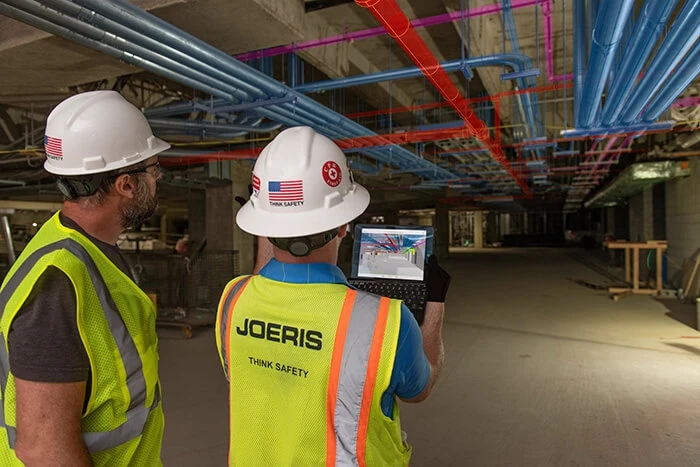& Construction

Integrated BIM tools, including Revit, AutoCAD, and Civil 3D
& Manufacturing

Professional CAD/CAM tools built on Inventor and AutoCAD
As digital construction gains wider adoption, there’s a new consensus: BIM isn’t BIM unless the entire project team uses it the same way. When the process is used effectively, the business value of BIM for owners cannot be overestimated.
Designers, builders, and owners are adapting their working methods to BIM, but data-rich gains are lost if each faction develops independent models. With a siloed BIM process, different teams end up replicating work through the design, fabrication, and operation phases. It wastes time and money, introduces more complexity, and compromises accuracy.
Getting teams to work from a single source of truth is less a technology issue and more a culture change, says Dave Pikey, vice president of corporate technology for mechanical contracting firm The Hill Group. “Technology is only a piece of the solution,” he says. “Behavior, understanding, knowledge, and common purpose are just as important.”
Building owners are uniquely positioned to rectify this disconnect. Owners’ roles typically stay constant throughout the stages of building and can dictate how designers, contractors, and subcontractors work together. “As an owner, if you’re involved in this process, you can help with the handoffs, the trust, and the data and provide incentives for folks to work together,” says Jeremy Woodgate, senior vice president and advanced technology business unit manager of construction-engineering firm SSOE. “Then, you get a product you can use digitally to manage your asset over the lifecycle of the building.”
When owners consider that initial work provides 50% in residual asset value over the lifecycle of a building or project, the need to align teams and processes from the outset comes into clearer focus. BIM offers a dataset that can lead their architects and builders to successful outcomes. With insights from designers, engineers, and client-owners, here are four reasons the business value of BIM for owners can’t be ignored.
Without a single integrated BIM dataset, awkward handoffs between stakeholders are often encoded in the contract agreement itself. “Whenever fabricators receive a model, most of the time they can’t—by contract—actually rely on that model,” says Alfonso Oliva, director of engineering firm LERA+. “They end up rebuilding a new model.”
Woodgate recalls one project in which “the design team did a model, and the construction team came back and had to trace over that model exactly,” he says. “The design team reviewed that to make sure the tracing matched exactly. Then, they were doing final field surveying to make sure the model fit the different pieces of construction. So they were creating a third model that represented what was actually being built; they had a design model, a construction model, and an actual as-built condition.”
Avoiding circular rounds of revisions ensures better collaboration and predictability of costs. That was the experience Brown University had with its Engineering Research Center, designed by Kieran Timberlake Architects and engineered by Buro Happold.
“Hosting the project models on the construction cloud enabled both the design and trade teams to collaborate in the same BIM model—meaning, as the project moves from design to construction and fabrication, there is no redundancy of model data,” says Paul McGilly, associate principal of digital design at Buro Happold. “The design BIM model transitions to a construction and fabrication model, a hugely efficient and collaborative process, and a true testament to all building stakeholders when they work together as a single team. As in this instance, a project can be delivered $10 million–$15 million within budget and delivered two months ahead of schedule.”
The complexity of building can hinder effective quality-control measures. Centralizing each project’s data with BIM allows rapid communication between teams in a shared, transparent environment. This record includes data on every component and its alteration history, giving owners a better understanding of their building process and product.
The collaborative, visual nature of BIM also can be used to explain the building’s design to stakeholders who may not have extensive experience with architecture, engineering, or digital modeling. “A lot of things happened in black boxes called ‘computers,’” Oliva says of the time before BIM. “Today, we can actually visualize everything with charts, 3D models, and virtual reality.”
“It’s a really great communication tool,” says John Cooke, senior program manager at Brown University, who worked with Paul McGilly on the Engineering Research Center. “We’re managing a new performing-arts center, and we’re using the [Autodesk] Revit model to communicate to stakeholders and donors what this building’s going to look like. We have fly-throughs generated so they can put on a set of virtual reality goggles and walk and fly through the building.”
BIM’s visual nature and depth of data also help disciplinary experts outside the initial building team, such as bidding subcontractors. “We’ve used BIM, transferred our models over to subcontractors, and let them bid on it,” says Erleen Hatfield, chief executive officer of design and engineering firm Hatfield Group. “When they have a model that’s put together properly, they spend their time thinking about how to put the building together. They can think about the more complex aspects of the project, and you get better bids.”
BIM provides unapparelled insight into how buildings function post-construction: things like MEP (mechanical, electrical, and plumbing) and HVAC systems, energy usage, and solar thermal performance. It’s an irreplaceable tool for building operations and key to reducing lifecycle costs, which are proportionally massive; 70%–80% of a building’s lifetime cost occurs after its construction. With teams working within a shared model, elements of operations and maintenance can be vetted in advance.
BIM helps owners fine-tune standard operations and maintenance, but it’s equally critical for renovations, additions, and retroactive commissioning. Any improvements can benefit from a dynamic BIM model of the existing building. BIM data will also likely help onboard upcoming digital building technology. “Any type of future technology platform, urban planning, or space planning is going to be much easier and more connected if we’re driving toward a better digital handover, better communication, earlier communication,” Pikey says.
At the end of the day, building owners are on the hook for their buildings’ costs; BIM helps teams spot errors earlier and debug designs, ironing out clashes on a computer, not in bricks and mortar. That makes it a critical risk-management tool.
“You’re controlling the risk because you understand what you’re modeling,” Hatfield says. “You’re putting it all together and can hand that off to the contractor in the exact form you want.” She sums up the value of sharing models downstream as, “less risk, less questions, and less problems.” Instead of avoiding risk by pushing off liabilities onto specific disciplines, BIM provides a more holistic solution: troubleshooting risk collaboratively from the outset.
“It’s your data,” Woodgate says. “You’ve paid for this model—the engineering model was created to show what you wanted as an end product. And if that gets thrown away and regenerated by the construction team, there’s a lot of waste there: There’s waste in cost, and some of what was intended may not translate well. So there’s a real need to have that data flow through.”
Simply sharing data, the most prized commodity owners have, is at the heart of the business value of BIM for owners. It offers new ways for teams to break down hierarchies, listen to each other, and document best practices. It’s time to “push yourself to work in a different way because what we’re talking about is really collaboration,” Cooke says. “And the more you collaborate, the better product you’re going to get in the end, and the better the process.”
This article was developed from the panel “Collaborative Delivery Between Design and Fabrication: Passing the Baton” at Autodesk University 2020.
Zach Mortice is an architectural journalist based in Chicago.
POV
POV
AECO








